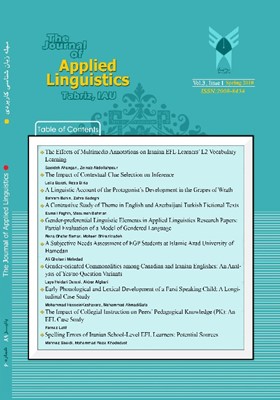The Effects of Multimedia Annotations on Iranian EFL Learners’ L2 Vocabulary Learning
الموضوعات : آموزش زبان انگلیسیسعیده آهنگری 1 , زینب عبدالله پور 2
1 - Department of English Language, Tabriz Branch, Islamic Azad
University, Tabriz, Iran
2 - Department of English Language, Tabriz Branch, Islamic Azad
University, Tabriz, Iran
الکلمات المفتاحية: Multimedia, Annotation/Gloss, Multimedia Annotation, Picture Annotation (Still Pictures), Video Annotation (Dynamic Pictures),
ملخص المقالة :
In our modern technological world, Computer-Assisted Language learning (CALL) is a new realm towards learning a language in general, and learning L2 vocabulary in particular. It is assumed that the use of multimedia annotations promotes language learners’ vocabulary acquisition. Therefore, this study set out to investigate the effects of different multimedia annotations (still picture annotations, dynamic picture annotations, and written annotations) on L2 vocabulary learning. To fulfill this objective, the researchers selected sixty four EFL learners as the participants of this study. The participants were randomly assigned to one of the four groups: a control group that received no annotations and three experimental groups that received: still picture annotations, dynamic picture annotations, and written annotations. Each participant was required to take a pre-test. A vocabulary post- test was also designed and administered to the participants in order to assess the efficacy of each annotation. First for each group a paired t-test was conducted between their pre and post test scores in order to observe their improvement; then through an ANCOVA test the performance of four groups was compared. The results showed that using multimedia annotations resulted in a significant difference in the participants’ vocabulary learning. Based on the results of the present study, multimedia annotations are suggested as a vocabulary teaching strategy.
Al-Seghayer, K. (2001). The Effect of Multimedia Annotation Modes on L2 Vocabulary Acquisition: A Comparative Study. Language Learning Technology, 5(1), 202-232.
Chun, D. M., & Plass, J. L. (1996). Effects of multimedia annotations on vocabulary acquisition. The Modern Language Journal, 80(2), 183-198.
Chun, D.M., Plass, J.L. (1997). Research on Text Comprehension in Multimedia Environments. Language Learning & Technology, 1(1), 60-81.
Dwyer, F. M., & Dwyer, C. (2003). Effect of animation in facilitating knowledge acquisition. Paper presented at the meeting of the Pennsylvania Educational Research Association, Hershey, PA.
Grabowski, B. L. (2006). Web-based animation or static graphics: is the extra cost of animation worth it? Journal of Educational Multimedia and Hypermedia. Retrieved February 10, 2009 from http://thefreelibrary.com
Groot, A. M. B. (2006). Effects of stimulus characteristics and background music on foreign language vocabulary learning and forgetting. Language Learning, 56(3), 463–506.
Jones, L.C., & Plass, J.L. (2002). Supporting Listening Comprehension and Vocabulary Acquisition in French with Multimedia Annotations. The Modern Language Journal, 86(4), 546-561.
Knight, S. (1994). Dictionary use while reading: The effects on comprehension and vocabulary acquisition for students of different verbal abilities. Modern Language Journal, 78(3), 285-299.
Kost, C. R., Foss, P., & Lenzini, J. J. (1999). Textual and pictorial glosses: Effectiveness on incidental vocabulary growth when reading in a foreign language. Foreign Language Annals, 32(1), 89-113.
Latham-koenig, C., & Seligson, P. (2007). New English file (Pre-intermediate). Oxford: Oxford University Press.
Levie, H.W. (1987). Research on Pictures: A Guide to the Literature. In D.M., Willows & H.A. Houghton (Eds.), The Psychology of Illustration, Vol. 1 (pp. 1-50). New York, Berlin, Heidelberg, Tokyo: Springer Verlag.
Lin, C. L. (2001). The effect of varied enhancements to animated instruction tests measuring different educational objectives. Language Learning Technology, 6 (1), 202-232.
Mayer, R. E. (1997). Multimedia learning: Are we asking the right questions? Educational Psychologist, 32(1), 1-19.
Mayer, R. E. (2001). Multimedia learning. Cambridge, UK: Cambridge University Press.
Mayer, R. E., & Moreno, R. (2000). Aids to computer-based multimedia learning, Learning and Instruction, 107–119. Retrieved February 21, 2009 from http://www.elsevier.com /locate/learninstruc. html
Najjar, L. J. (1998). Principles of educational Multimedia User Interface Design. Human Factors, 40(2), 311-323.
Nikolova, O. R. (2002) Effects of Students' Participation in Authoring of Multimedia Materials on Student Acquisition of Vocabulary. Journal of Language Learning & Technology, 6, 215-241.
Oxford, R., & Crookall, D. (1990). Vocabulary learning: A critical analysis of techniques. TESL Canada Journal, 7(2), 9-30.
Paivio, A. (1986). Mental representation: A dual-coding approach. New Oxford University Press.
Rieber, L. P. (1990). Computers, graphics, and learning. Retrieved February 20, 2009 from http://www.nowhereroad.com /cgl/toc2535.html
Schmitt, N., Schmitt, D., & Clapham, C. (2001). Developing and exploring the behavior of two new versions of the Vocabulary Levels Test. Language Testing, 18 (1), 55-88.
Son, J. B. (2001). CALL and vocabulary learning: A review. English Linguistic Science,7, 27-35 [Online]. Retrieved November 15, 2009 from http://www.usq.edu.au/users/sonjb /papers/elsak01.htm
Underwood, J. (1984). Linguistics, computers and the language teacher: a communicative approach. Rowley, MA: Newbury House.
Wittrock, M. C. (1990). Generative processes of comprehension. Educational Psychologist, 24, 345-376.
Consulted online dictionaries:
http://www.kidcrosswords.com
http://www.dicts.info/picture-dictionary.php?lan=dutch
http://www.enchantedlearning.com/Bisfor.shtml
http://www.pidic.com/
http://www.csdm.qc.ca/stejarc/dictionnaire/dico.htm
http://www.ldoceonline.com/
http://www.infovisual.info/01/pano_fr.html
http://www.pdictionary.com/
http://www.visualthesaurus.com/?ad=google.vocabulary.thinkvisually&gclid=CJXex6e4towC FQPqXgodgX-HNw
http://www.matton.fr/search.php?next=1&lsok=1&sok=soaking%20we


